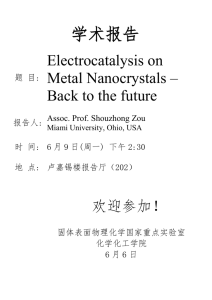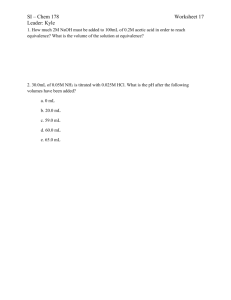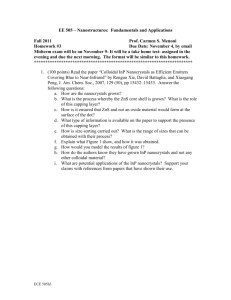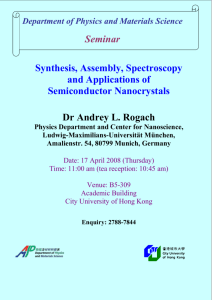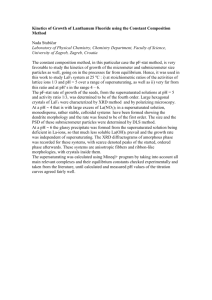Document 10475515
advertisement
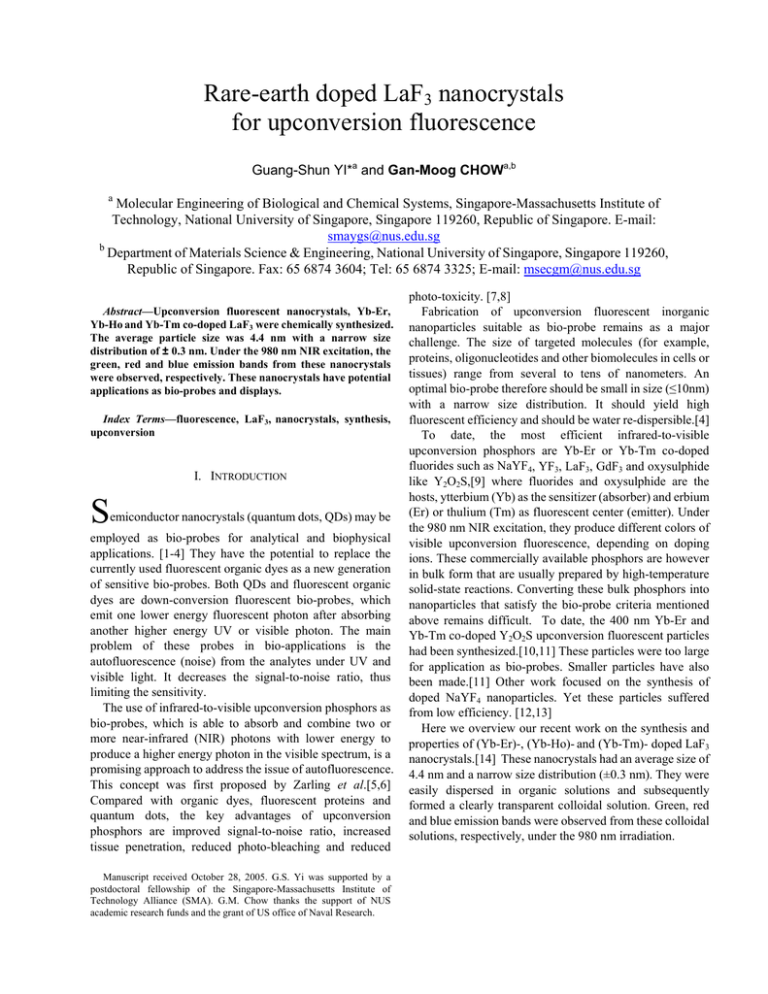
Rare-earth doped LaF3 nanocrystals for upconversion fluorescence Guang-Shun YI*a and Gan-Moog CHOWa,b a Molecular Engineering of Biological and Chemical Systems, Singapore-Massachusetts Institute of Technology, National University of Singapore, Singapore 119260, Republic of Singapore. E-mail: smaygs@nus.edu.sg b Department of Materials Science & Engineering, National University of Singapore, Singapore 119260, Republic of Singapore. Fax: 65 6874 3604; Tel: 65 6874 3325; E-mail: msecgm@nus.edu.sg Abstract—Upconversion fluorescent nanocrystals, Yb-Er, Yb-Ho and Yb-Tm co-doped LaF3 were chemically synthesized. The average particle size was 4.4 nm with a narrow size distribution of ± 0.3 nm. Under the 980 nm NIR excitation, the green, red and blue emission bands from these nanocrystals were observed, respectively. These nanocrystals have potential applications as bio-probes and displays. Index Terms—fluorescence, LaF3, nanocrystals, synthesis, upconversion I. INTRODUCTION S emiconductor nanocrystals (quantum dots, QDs) may be employed as bio-probes for analytical and biophysical applications. [1-4] They have the potential to replace the currently used fluorescent organic dyes as a new generation of sensitive bio-probes. Both QDs and fluorescent organic dyes are down-conversion fluorescent bio-probes, which emit one lower energy fluorescent photon after absorbing another higher energy UV or visible photon. The main problem of these probes in bio-applications is the autofluorescence (noise) from the analytes under UV and visible light. It decreases the signal-to-noise ratio, thus limiting the sensitivity. The use of infrared-to-visible upconversion phosphors as bio-probes, which is able to absorb and combine two or more near-infrared (NIR) photons with lower energy to produce a higher energy photon in the visible spectrum, is a promising approach to address the issue of autofluorescence. This concept was first proposed by Zarling et al.[5,6] Compared with organic dyes, fluorescent proteins and quantum dots, the key advantages of upconversion phosphors are improved signal-to-noise ratio, increased tissue penetration, reduced photo-bleaching and reduced Manuscript received October 28, 2005. G.S. Yi was supported by a postdoctoral fellowship of the Singapore-Massachusetts Institute of Technology Alliance (SMA). G.M. Chow thanks the support of NUS academic research funds and the grant of US office of Naval Research. photo-toxicity. [7,8] Fabrication of upconversion fluorescent inorganic nanoparticles suitable as bio-probe remains as a major challenge. The size of targeted molecules (for example, proteins, oligonucleotides and other biomolecules in cells or tissues) range from several to tens of nanometers. An optimal bio-probe therefore should be small in size (≤10nm) with a narrow size distribution. It should yield high fluorescent efficiency and should be water re-dispersible.[4] To date, the most efficient infrared-to-visible upconversion phosphors are Yb-Er or Yb-Tm co-doped fluorides such as NaYF4, YF3, LaF3, GdF3 and oxysulphide like Y2O2S,[9] where fluorides and oxysulphide are the hosts, ytterbium (Yb) as the sensitizer (absorber) and erbium (Er) or thulium (Tm) as fluorescent center (emitter). Under the 980 nm NIR excitation, they produce different colors of visible upconversion fluorescence, depending on doping ions. These commercially available phosphors are however in bulk form that are usually prepared by high-temperature solid-state reactions. Converting these bulk phosphors into nanoparticles that satisfy the bio-probe criteria mentioned above remains difficult. To date, the 400 nm Yb-Er and Yb-Tm co-doped Y2O2S upconversion fluorescent particles had been synthesized.[10,11] These particles were too large for application as bio-probes. Smaller particles have also been made.[11] Other work focused on the synthesis of doped NaYF4 nanoparticles. Yet these particles suffered from low efficiency. [12,13] Here we overview our recent work on the synthesis and properties of (Yb-Er)-, (Yb-Ho)- and (Yb-Tm)- doped LaF3 nanocrystals.[14] These nanocrystals had an average size of 4.4 nm and a narrow size distribution (±0.3 nm). They were easily dispersed in organic solutions and subsequently formed a clearly transparent colloidal solution. Green, red and blue emission bands were observed from these colloidal solutions, respectively, under the 980 nm irradiation. II. EXPERIMENTAL a b Fig. 1. (a) TEM micrograph of well-dispersed LaF3:12%Yb,3%Er nanocrystals at a magnification of 100K. (b) TEM micrograph of LaF3:12%Yb,3%Er nanocrystals at higher magnification of 600K. High crystallinity of the particles could be observed. 350 (111) 300 LaF3:Yb,Er 250 (300) (113) 200 (223) 100 50 (411) (302) 150 (112) C. Synthesis of the nanocrystals In a typical procedure for the preparation of LaF3:12%Yb,3%Er nanocrystals, 0.378g of NaF (9mmol) was dissolved in 50mL of de-ionized water. Then 50 ml of ethanol was added and the whole solution was heated to 70oC. 2.585 g (4mmol) ammonium di-n-octadecyldithiophosphate was subsequently added and dissolved. Another solution was prepared by mixing 8.5ml of 0.4mol.L-1 LaCl3, 1.2ml of 0.4 mol.L-1 YbCl3 and 0.3ml of 0.4 mol.L-1 ErCl3 stock solutions together (4mmol rare earth ions totally) and swiftly injected into the NaF solution through a 10 ml syringe. White precipitates instantly appeared. After 2 h, the reaction mixture was placed in a 60oC oven for 2 h, an oil product layer was seen to segregate to the bottom of the mixture. The product was separated, and washed three times using anhydrous ethanol and once with de-ionized water. After drying for two days under vacuum, 0.6374g white powder was obtained. For the synthesis of the other two nanocrystals, a molar ratio of La:Yb:Ho = 79:20:1 for LaF3:Yb,Ho, and La:Yb:Tm = 89:10:1 for LaF3:Yb,Tm, were adopted for the respective preparation following the same procedures. A. Morphology, structure and composition of the nanocrystals Figure 1 shows the typical TEM bright field image of the LaF3:12%Yb,3%Er nanocrystals. The dispersed particles suggested that the long chain ligand on the crystal surface prevented aggregation. The average diameter of the nanocrystals was 4.4 nm, with a standard derivation of ±0.3 nm. Figure 1b is a high-resolution TEM image of LaF3:12%Yb,3%Er nanocrystals. Most of the nanocrystals were equiaxed with well-defined crystallinity. Similar TEM results were also observed for LaF3:20%Yb,1%Ho and LaF3:10%Yb,1%Tm nanocrystals. (002) B. Characterization The nanocrystals were investigated using transmission electron microscopy (TEM) and x-ray diffraction (XRD). The upconversion fluorescence spectra were measured using a luminescence spectrometer with an external 980nm laser diode (2W, continuous wave) as the excitation source in place of the xenon lamp in the spectrometer. The spectrometer was operated at the bioluminescence mode, with gate time 100ms, delay time 0ms, cycle 0 and flash count 1. The sample was measured in two ways. For powder nanocrystals, 0.2 g sample was filled in the Powder holder and reproducibly positioned in the Front Surface accessory. For colloidal samples, a nanocrystal concentration of 0.1 wt.-% in dichloromethane was used. III. RESULTS AND DISCUSSION Intensity / a.u. A. Chemicals Lanthanum chloride heptahydrate (LaCl3.7H2O, 99.99%), ytterbium chloride hexahydrate (YbCl3.6H2O, 99.99%), erbium chloride hexahydrate (ErCl3.6H2O, 99.99%), holmium chloride hexahydrate (HoCl3.6H2O, 99.99%), thulium chloride hexahydrate (TmCl3.6H2O, 99.99%), and sodium fluoride (NaF) were obtained from Sigma-Aldrich (Sigma-Aldrich, Singapore). Ammonium di-n-octadecyldithiophosphate was synthesized according to the literature.[15] Ultra pure water (18.0 MΩ) from a Milli-Q deionization unit was used throughout the experiment. Rare earth chloride stock solutions with a concentration of 0.4 mol.L-1 were prepared by dissolving LaCl3.7H2O, YbCl3.6H2O, ErCl3.6H2O, HoCl3.6H2O and TmCl3.6H2O respectively in de-ionized water. The final solutions were maintained at pH 2 to avoid hydrolysis. 0 20 40 60 80 2-Theta-Scale Fig. 2. X-ray powder diffraction patterns of the LaF3:12%Yb,3%Er, nanocrystals. Similar TEM results were also observed for LaF3:20%Yb,1%Ho and LaF3:10%Yb,1%Tm nanocrystals. Figure 2 shows the XRD of the LaF3:12%Yb,3%Er nanocrystals. Due to the small x-ray coherence domain size (small particle size), peak broadening was observed. The x-ray peak positions and intensities of the nanocrystals were similar and showed slight deviations from the hexagonal bulk LaF3 crystal (PDF 72-1435). The average particle size estimated by line-broadening was 4.3 nm. Compared with B. Upconversion fluorescence Figure 3 shows the room-temperature upconversion fluorescence spectra (Fig. 3 a, c and e) and their corresponding mechanisms (b, d and f) of LaF3:12%Yb,3%Er, LaF3:20%Yb,1%Ho and LaF3:10%Yb,1%Tm nanocrystals. For LaF3:12%Yb,3%Er nanocrystals (Fig. 3a), under 980 nm NIR excitation, there were three emission peaks at 520.8, 545 and 658.8 nm, which were assigned to 4H11/2 to 4I15/2 , 4S3/2 to 4I15/2 and 4F9/2 to 4I15/2 transition of erbium, respectively. [12,16,17] With the 980nm excitation, Yb3+ (sensitizer) absorbed one 980 nm photon and then transferred it to emitter Er3+. The Er3+ received the energy and its ground-state (4I15/2) electron was excited to 4I11/2 level. A second photon from Yb3+ promoted the electron to 4F7/2 level. The excited electron decayed first non-radiatively to 2H11/2, 4S3/2 and 4F9/2 levels. When it decayed further to the ground state, emission at 520.8, 545 and 658.8 nm occurred, as shows in Fig. 3b. For LaF3:20%Yb,1%Ho nanocrystals, the strong red emissions at 644.73 and 657.8 nm (Fig. 3c) were assigned to the 5 F5—5I8 transition, and the weaker green emission at 542.4 nm corresponded to 5S2—5I8 transition (Fig. 3d). [18-20] For LaF3:10%Yb,1%Tm nanocrystals, the blue emission band at 475.2 nm corresponded to the transition from 1G4 to 3H6. A strong near infrared emission at 800.2 nm was attributed to the transition from 1G4 to 3H5 (Fig. 3, e and f). [21] 4 F7/2 2 4H11/2 S3/2 Intensity / a.u. 500 400 4 F 4 9/2 I9/2 4 I11/2 300 2 F5/2 200 4 0 400 I13/2 980 nm 100 500 600 700 Wavelength / nm a 2 S2 Intensity / a.u. 5 F5 600 500 400 2 F5/2 300 200 5 I6 5 I7 980 nm 100 0 2 500 600 5 F7/2 700 Wavelength / nm Yb c I8 Ho 542 645,658 nm Ho d 1 G4 250 200 3 F3 150 3 H4 100 2 F5/2 3 H5 50 3 F4 980 nm 0 400 500 600 700 800 Wavelength / nm 900 2 3 F7/2 Yb e H6 Tm 475 800 nm Tm f Fig. 3. Room-temperature upconversion fluorescence spectra (a, c and e) and corresponding mechanism (b, d and f) of the LaF3:12%Yb,3%Er, LaF3:20%Yb,1%Ho and LaF3:10%Yb,1%Tm nanocrystals under the 980 nm NIR excitation. Dotted arrows indicate nonradiative energy transfer and solid arrows refers to radiative processes. From Figure 3, the three nanocrystals yielded different fluorescent emissions under the same 980 nm NIR excitation. For the three nanocrystals, the four strong peaks were: 475.2 nm blue emission from LaF3:10%Yb,1%Tm, 545 nm green emission from LaF3:12%Yb,3%Er, 657.8 nm red emission from LaF3:20%Yb,1%Ho and 800.2 nm NIR emission for LaF3:10%Yb,1%Tm. These results indicated the promising potential of these materials as bio-probes, especially in the multiple labelling. Under the 980 nm NIR excitation, it is possible to simultaneously detect multiple analytes labeled with different colors of probes. The measured upconversion fluorescent efficiency of the LaF3:12%Yb,3%Er nanocrystals, was 5-times-higher than our previously reported cubic phase NaYF4:20%Yb3+,2%Er3+ nanocrystals.[12] However, it remains weaker (1-2 orders of decrease) when compared with their corresponding bulk phosphors from solid-state synthesis. Further work on size-surface effects on upconversion properties, surface functionalization and sensitivity of molecular detection are currently being pursued. 4 F7/2 Yb 5 700 Intensity / a.u. TEM results, the particles were confirmed to be single crystals. Similar XRD results were also obtained for LaF3:20%Yb,1%Ho and LaF3:10%Yb,1%Tm nanocrystals, respectively. The ligand-capped LaF3:12%Yb,3%Er, LaF3:20%Yb,1%Ho and LaF3:10%Yb,1%Tm nanocrystals, were easily dispersed in organic solvents and formed a transparent colloidal solution. For organic solvents such as dichloromethane, chloroform and hexane, as high as 5 mg nanocrystals were dissolved in 1 ml of solvents. When an equal volume of ethanol was added in the organic solutions, their dispersion significantly increased. Since the ligand itself preferred to disperse in such ethanol-organic solutions, it enhanced the dispersibility of the nanocrystals in such systems. I15/2 Er b 521 545 659 nm Er ACKNOWLEDGMENT We thank B.H. Liu for help of HRTEM measurements. G.S. Yi was supported by a postdoctoral fellowship of the Singapore-Massachusetts Institute of Technology Alliance (SMA). G.M. Chow thanks the support of NUS academic research funds and the grant of US office of Naval Research. References 1. W. C. W. Chan and S. M. Nie, "Quantum dot bioconjugates for ultrasensitive nonisotopic detection," Science 281, 2016-2018 (1998). 2. M. Bruchez, M. Moronne, P. Gin, S. Weiss, and A. P. Alivisatos, "Semiconductor nanocrystals as fluorescent biological labels," Science 281, 2013-2016 (1998). 3. D. Gerion, F. Pinaud, S. C. Williams, W. J. Parak, D. Zanchet, S. Weiss, and A. P. Alivisatos, "Synthesis and properties of biocompatible water-soluble silica-coated CdSe/ZnS semiconductor quantum dots," Journal of Physical Chemistry B 105, 8861-8871 (2001). 4. B. Dubertret, P. Skourides, D. J. Norris, V. Noireaux, A. H. Brivanlou, and A. Libchaber, "In vivo imaging of quantum dots encapsulated in phospholipid micelles," Science 298, 1759-1762 (2002). 5. Zarling, D. A., Rossi, M. J., Peppers, N. A., Kane, J., Faris, G. W., Dyer, M. J., Ng, S. Y., and Schneider, L. V. Up-converting reporters for biological and other assays using laser excitation techniques. SRI, I. N. T. E. [US Patent 5674698]. 6. F. van de Rijke, H. Zijlmans, S. Li, T. Vail, A. K. Raap, R. S. Niedbala, and H. J. Tanke, "Up-converting phosphor reporters for nucleic acid microarrays," Nature Biotechnology 19, 273-276 (2001). 7. J. G. White, J. M. Squirrell, and K. W. Eliceiri, "Applying multiphoton imaging to the study of membrane dynamics in living cells," Traffic 2, 775-780 (2001). 8. J. A. Feijo and N. Moreno, "Imaging plant cells by two-photon excitation," Protoplasma 223, 1-32 (2004). 9. G. Blasse and B. C. Grabmaier, Luminescent Materials, (Springer, Berlin, 1994). 10. Sanjurjo, A., Lau, K.-H., Lowe, D., Canizales, A., Jijang, N., and Wong, V. production of substantially monodisperse phosphor particles. [US Patent 6039894]. 2000. 11. P. Corstjens, S. Li, M. Zuiderwijk, S. Adam, R. S. Niedbala, and H. Tanke, "infrared up-converting phosphors for bioassays," IEEE Proc. -Nanobiotechnol. 152, 64-72 (2005). 12. G. S. Yi, H. C. Lu, S. Y. Zhao, G. Yue, W. J. Yang, D. P. Chen, and L. H. Guo, "Synthesis, characterization, and biological application of size-controlled nanocrystalline NaYF4 : Yb,Er infrared-to-visible up-conversion phosphors," Nano Letters 4, 2191-2196 (2004). 13. S. Heer, K. Kompe, H. U. Gudel, and M. Haase, "Highly efficient multicolour upconversion emission in transparent colloids of lanthanide-doped NaYF4 nanocrystals," Advanced Materials 16, 2102-+ (2004). 14. G. S. Yi and G. M. Chow, "Colloidal LaF3:Yb,Er, LaF3:Yb,Ho and LaF3:Yb,Tm nanocrystals with multicolor upconversion fluorescence," Journal of Materials Chemistry 15, 4460-4464 (2005). 15. J. W. Stouwdam and F. C. J. M. van Veggel, "Near-infrared emission of redispersible Er3+, Nd3+, and Ho3+ doped LaF3 nanoparticles," Nano Letters 2, 733-737 (2002). 16. S. L. Zhao, Y. B. Hou, and L. Sun, "Upconversion luminescence of ZBLAN:Er3+,Yb3+," Journal of Northern Jiaotong University 24, 89-92 (2000). 17. G. S. Yi, B. Q. Sun, F. Z. Yang, D. P. Chen, Y. X. Zhou, and J. Cheng, "Synthesis and characterization of high-efficiency nanocrystal up-conversion phosphors: Ytterbium and erbium codoped lanthanum molybdate," Chemistry of Materials 14, 2910-2914 (2002). 18. F. Lahoz, I. R. Martin, and D. Alonso, "Theoretical analysis of the photon avalanche dynamics in Ho3+-Yb3+ codoped systems under near-infrared excitation," Physical Review B 71, (2005). 19. F. Lahoz, I. R. Martin, and A. Briones, "Infrared-laser induced photon avalanche upconversion in Ho3+-Yb3+ codoped fluoroindate glasses," Journal of Applied Physics 95, 2957-2962 (2004). 20. F. Z. Yang, G. S. Yi, D. P. Chen, and J. Cheng, "Synthesis and up-conversion luminescence properties of nanocrystal Yb, Ho co-doped sodium yttrium fluoride," Chemical Journal of Chinese Universities-Chinese 25, 1589-1592 (2004). 21. S. Heer, O. Lehmann, M. Haase, and H. U. Gudel, "Blue, green, and red upconversion emission from lanthanide-doped LuPO4 and YbPO4 nanocrystals in a transparent colloidal solution," Angewandte Chemie-International Edition 42, 3179-3182 (2003).
